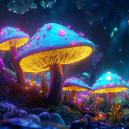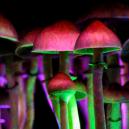Psilocybin and Psilocin: Understanding Their Role
Published :
September 13th, 2016
Categories :
Effects

Magic Mushrooms work by introducing psychoactive chemicals into the the bloodstream that bind with the brain's serotonin receptors. We take a closer look at exactly what they are.
Magic mushrooms have long been a part of psychedelic culture all around the world. They are consumed in shamanistic rituals and to trip out with your mates on a Friday night. Stepping through the passageway and into the cosmic realm is as easy as eating a handful of caps. But what exactly are you doing when you take that leap? What is it that is actually occurring as your consciousness soars past Jupiter?
PSYCHEDELIC MUSHROOMS
Psychedelic mushrooms (and truffles) have, for some, opened a door to another world. They are a special variety of mushroom. You're not going to find them at your local market. The first thing you should know is that mushrooms are a fungus, falling into a genus called Psilocybe. They tend to grow in warm, moist environments and can be found growing throughout the countryside of Europe. Magic mushrooms contain two primary compounds responsible for your hallucinogenic experience, psilocybin and psilocin. These psilocybe mushrooms induce what is commonly known as a trip or tripping.
This occurs when the psychedelic compounds in the mushroom interact with the brain, more specifically, the serotonin receptors. The results can be life changing. Consumers of magic mushrooms experience vivid hallucinations and often feel an overwhelming sensation of oneness with things. Time and space take on new meaning. Many describe it as a religious experience. Consuming psychedelic mushrooms will change the way you look at yourself, the world around you and ultimately your place in this vast universe we call home. But how does it all work?
PSILOCYBIN
Psilocybin is the psychoactive compound that acts as the chemical precursor for psilocin. When you consume a magic mushroom, your body will start to break it down, releasing psilocybin and psilocin into the digestive tract. Magic mushrooms contain only a small amount of psilocin compared to the amount of psilocybin present. As the compounds are absorbed, the psilocin enters the blood stream and heads for the brain. The psilocybin undergoes an additional metabolic process that breaks it down into psilocin. This process is known as dephosphorylation.
Psilocybin is a chain of elements that is similar in structure to psilocin. When consumed orally the psilocybin is broken down by an enzyme called Alkaline phosphate. The enzyme removes a portion of the chemical structure containing phosphorous, oxygen and hydrogen, known as a phosphate group. After the dephosphorylation process is complete, the psilocin that has been converted is now free to enter the bloodstream. Once psilocybin is consumed, the effects are usually felt between thirty minutes and one hour. This is how long the dephosphorylation process takes.
PSILOCIN
Now that the psilocin is in the bloodstream, it makes its way toward the serotonin receptors. Serotonin is what is known as a neurotransmitter. It is greatly responsible for controlling our mood. The psilocin is similar in structure to serotonin and partially binds with the serotonin receptor. This is when your trip begins. You may initially feel your heart beat faster. Your senses may seem more acute. You might start to feel an overwhelming feeling of wellness and tranquillity. This is all due to the interaction of the psilocin and the serotonin receptors located throughout the brain. The location of the various receptors can be linked to specific effects by the psilocin. For example, receptors in the cerebral cortex that are affected by psilocin will undoubtedly alter your emotional state.
Psilocin is what is known as a tryptamine alkaloid. Basically, it is an organic compound, comprised primarily of hydrogen and carbon, which is created by various forms of fungus. Humans also produce tryptamine, like 5-Hydroxytryptamine, otherwise known as serotonin. Both are very similar combinations of Nitrogen, Hydrogen, Carbon, and Oxygen. The similarity in structure allows the psilocin to function as a partial agonist.
Partial agonists are able to bind to specific receptors due to the chemical similarities with the neurotransmitters they are substituting. After a period of peak interaction, the psilocin is then metabolized by the body, and the effects begin to wear off. After the body excretes the psilocin, there is a period of readjustment for your serotonin receptors, resulting in that feeling of “coming down.”
Although both psilocybin and psilocin are both psychoactive, psilocin is very unstable. This is why there is not as much present in the mushroom – as light and heat break it down. It is why you don’t really hear much about it, as it is not present in large amounts until it is converted from psilocybin. It is also why scientific research focuses on psilocybin, as psilocin is too delicate to work with in comparison.
NEW UNDERSTANDINGS
Much surrounding the nature of the psychedelic experience is still a mystery. Scientists have found, however, that after consuming psychedelic mushrooms, different areas of the brain begin to communicate with each other that typically do not. It could be suggested that this hyper-connectivity of the brain and creation of pathways between those newly-connected regions are responsible for the sensations of enlightenment and introspection. Science is even starting to examine these seemingly beneficial side effects of magic mushrooms and other hallucinogenics with hopes of one day treating psychological disorders like depression and PTSD. Coming to understand the physical interactions between compounds like psilocybin and our brain will undoubtedly shed a light on some of the long-standing questions we have had about the psychedelic experience.


















